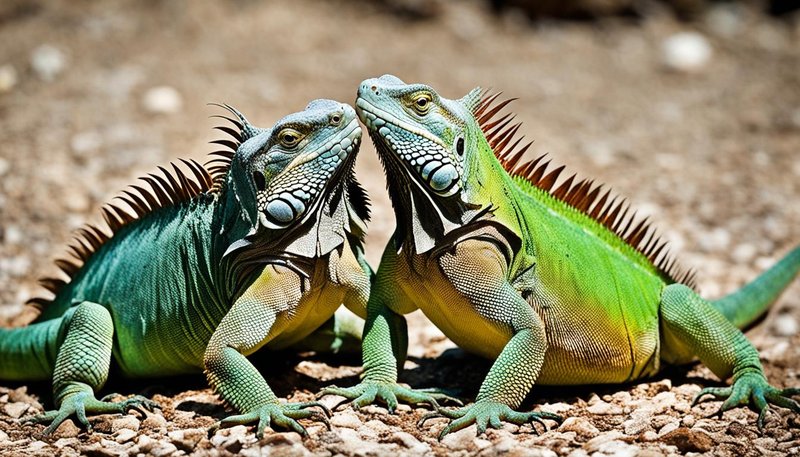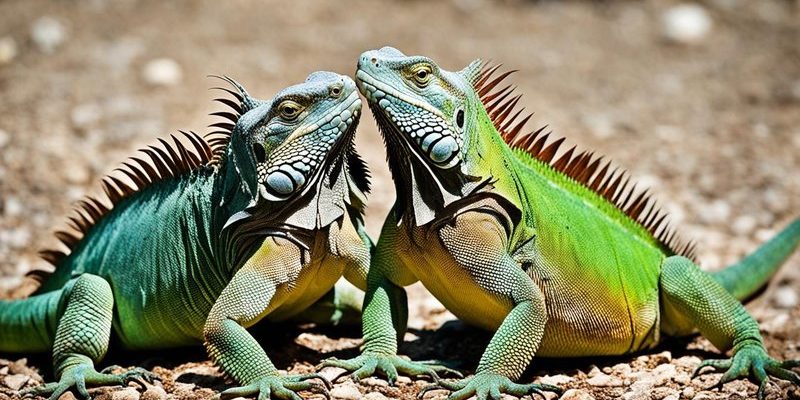
Breeding iguanas can seem daunting, especially if you’re new to reptile care. But once you understand their natural behaviors and needs, it becomes much clearer. Think of it like piecing together a puzzle; every detail matters, and when you see the big picture, everything falls into place. Whether you’re just curious about their reproductive lives or considering breeding them, this guide covers the essentials, breaking it down step by step.
Understanding Iguana Mating Seasons
The breeding season for iguanas typically starts in the spring and lasts until early summer. This timing is crucial because it aligns with warmer temperatures and increased food availability, which are key for reproduction. In the wild, iguanas sense the changing seasons through environmental cues like temperature and daylight. These changes trigger hormonal shifts that prepare them for mating.
During this period, male iguanas become quite active and territorial. They often display signs of aggression towards other males as they compete for access to females. You might see them bobbing their heads, puffing up their bodies, or even engaging in physical confrontations. This behavior is not just for show; it’s a way for males to assert dominance and attract potential mates.
Females, on the other hand, might seem less aggressive but are very selective. They choose males based on physical prowess and displays of strength. A female might observe males for a while, looking for one that shows good health and vigor before making her choice. It’s almost like a dance of selection, where both parties play their parts to ensure the best chance of successful breeding.
The Courtship Rituals
Once a female iguana is interested, the courtship process begins. Male iguanas will often perform elaborate displays to woo a female. These rituals can include head bobbing, tail waving, and even some light biting. It’s essential to note that these behaviors are part of a complex social interaction and not just random movements.
The courtship can be quite a sight—imagine a small dragon strutting its stuff to impress a mate. The males display vibrant colors, puffing out their throat sacs and showing off their size. You might be wondering how this looks in a pet iguana setting. Well, if you have a male and female together, you may see him trying to impress her through these behaviors.
Once the female is receptive, mating can occur. Copulation usually lasts just a few minutes but can happen multiple times over a few days. The male will grasp the female by her neck with his jaws during this time, which might look a bit rough, but it’s a natural part of their mating process.
Egg Laying and Nesting Behavior
After successful mating, female iguanas prepare to lay their eggs. They typically require a warm, moist environment for this part of the process. In the wild, females will dig holes in sandy or loose soil to create nest sites. This behavior keeps the eggs safe from predators and provides the right conditions for incubation.
In a captive setting, it’s crucial to provide a suitable nesting area. If your female iguana is showing signs of nesting behavior, like digging or becoming restless, it’s time to offer a nesting box filled with suitable substrate. You can use a mix of sand and soil to help mimic their natural environment.
Once she lays her eggs, the female will usually cover them up and may not show much interest afterward. This can be quite surprising for new iguana owners, but it’s perfectly normal. She doesn’t typically exhibit parental care after laying. Instead, her focus shifts back to her health and recovery.
Incubation and Hatching
Egg incubation is a fascinating stage in the reproductive cycle of iguanas. The temperature and humidity in the nesting environment play a critical role in the development of the eggs. Typically, iguana eggs take about 60 to 90 days to hatch, depending on the temperature.
In warmer conditions, eggs develop faster, while cooler temperatures can slow down the process. Maintaining the right humidity level is also important; too little can dry out the eggs, while too much can cause them to rot. If you’re breeding iguanas, investing in an incubator can help control these conditions more effectively.
When the baby iguanas are ready to hatch, you might notice them making tiny cracks in the eggshell. This is an exciting moment! Once they break free, the hatchlings will usually remain in the nest for a short period to rest and gather strength before venturing out into the world. Their first steps are quite a sight to behold, as they scurry off to find food and shelter.
Behavior of Hatchling Iguanas
After hatching, baby iguanas are independent. Unlike many mammals, they don’t rely on their parents for food or protection. Instead, they instinctively know how to find food and avoid predators. However, this stage is incredibly risky; hatchlings are vulnerable to a range of threats, including birds and other reptiles.
In captivity, it’s crucial to provide a safe and enriching environment for young iguanas. They’ll need access to plenty of greens, fruits, and proper UV lighting to thrive. Social interaction is also essential; young iguanas can become skittish without proper handling and exposure to people. The transition from hatchling to juvenile is a critical period, and creating a calm environment will help them grow into healthy adults.
If breeding iguanas, be mindful of the potential for overpopulation. Carefully considering the number of hatchlings you can provide for is essential. Responsible breeding practices are vital to ensuring the health and well-being of both parents and offspring.
The breeding and reproductive behavior of iguanas is nothing short of remarkable. From the courtship displays of males to the independence of hatchlings, every phase is filled with specific behaviors that ensure the survival of the species. Understanding these processes not only enriches your knowledge of iguanas but can also enhance your experience if you’re considering breeding them.
Whether you’re captivated by their courtship rituals or invested in creating a nurturing environment for hatchlings, iguanas offer a world of wonder. By appreciating their reproductive behaviors and providing proper care, you can foster healthy iguanas and contribute to a better understanding of these beautiful reptiles. Each step of their reproductive journey tells a story of adaptation and survival, making them truly fascinating creatures to observe and learn about.

